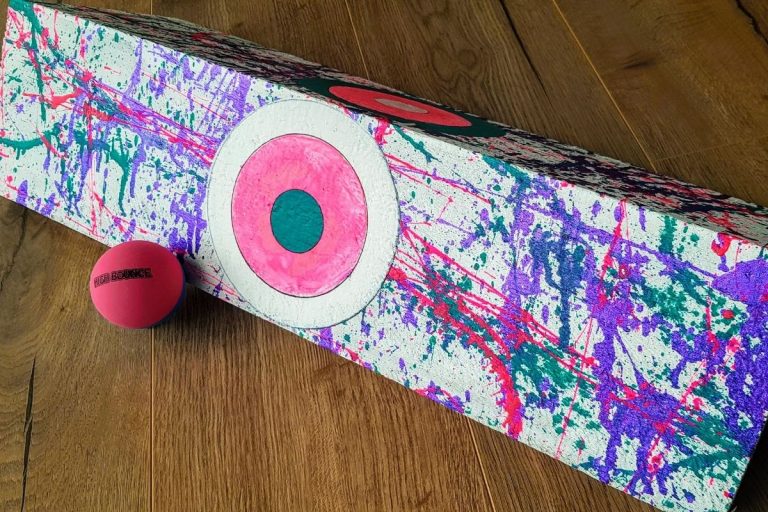Gutter board is one of the most underrated games to come out of the 80s. Sure Skip-it was all the rage for a bit, slip-n-slide was cool and the moon hopper is iconic. But even these famous outdoor toys can’t match the ridiculously simple fun of throwing a ball at a board… and catching it again.
Gutterboard is like a weird mashup of catch, sevens, bean-bag toss and cricket without bats. It’s possibly one of the best hand-eye coordination, fine-motor development games you can play with a ball. It’s addictive and loads of fun, and will drive you crazy trying to win!
And best of all, gutter board was invented right here in New Zealand. In fact, the first boards were no doubt made out of left over fence palings. A classic bit of number 8 wire Kiwi ingenuity!
Why Throwing and Catching Games are Great for Kids’ Development
Small ball skills are awesome for teaching children a whole range of motor skills and brain development. Kid Activities says a whole range of skills are improved by playing throwing games. They list these 4 broad kid’s development areas that throwing and catching games improve:
- Improves hand-eye coordination. Developing good hand-eye coordination is an essential part of a child’s development. It allows a child to direct and control their limbs, making it possible to interact with objects in the physical world more easily.
- Improves fine motor skills. Fine motor skills is the coordination of small muscles, like those in the fingers and hands, with the eyes. Developing fine motor skills gives children the dexterity necessary to perform complex tasks like picking up and arranging small objects.
- Improves gross motor skills. Gross motor skills involve whole body movement and the engagement of larger muscles like those in the core. Developing gross motor skills is essential for performing every day tasks like standing, walking, running, and jumping.
- Improves timing and prediction. Many children struggle with timing when they are learning to throw and catch balls. Throwing games will help them quickly develop this skill. They also learn the physical characteristics balls, developing an understanding how how they bounce and roll.
How to Make a Gutter Board Game
You will need:
1 x 1200mm long 150x40mm timber fence rail, or 150x20mm fence paling (ideally treated to H3.2)
3 x 75mm stainless steel self-taping decking screws
Sandpaper
Resene Quick-dry Primer
Resene test pots in Yowza, FX Fluoro Pink and Funtasia
Paint brush
A saucer, round plant pot and a test-pot lid to trace around
Paper cups or jars to mix up paint
What to do:
1. To make the gutterboard, first cut the 1200mm long fencing rail through the centre, to create 2 pieces 600mm long each.
2. Now ask a friend to tightly hold the two pieces of timber together on the long edge to form a triangle shape. Using a power drill, drill the 3 self-taping screws through the face of one rail into the top edge of the other. One screw on each end, and one on centre. Be careful to keep the screws straight.
3. If your fence rail is rough sawn, you can smooth it off with the sandpaper, and round off any sharp corners. You can also plaster any cracks to keep out water.
4. Now it’s time to paint your gutter board using the Resene Quick-dry Primer.
5. While the primer is drying, tip roughly about 2 tablespoons of Resene Yowza, Funtasia and Fx Fluoro Pink into seperate cups. Then add about 1 tablespoon of water. This will make the paint runny enough to flick onto the board. You are looking for a consistency that is just dripping off the brush. Adjust as you need to.
6. It’s time to head on outside and start flicking. Make sure your kids are wearing clothes you don’t mind getting messy. And you may want to put down an old sheet, or do this on the grass. Basically let them go for it until they feel they have flicked enough of each colour. Let them have fun with it!
7. Once the flicked on paint has dried it’s time to paint on the target. For this you need 3 different size round objects you can draw around. I used a saucer, small plant pot and one of the test pot lids. Do the largest circle first, and paint this in, you may need to do 2 coats to cover. Wait until the paint is touch dry before re-coating.
8. Then paint in the next 2 circles, waiting between each coat for the paint to dry. Once the paint is dry, it’s time to play!
How to Play Gutter Board
The aim of gutter board is to throw the ball against the board and catch it on the full when it bounces back to you.
To play you draw 3 lines on the ground, each going further out from the board, in both directions. Each player then has to throw the ball from behind the line and catch it 5 times in a row. Each time you catch 5 in a row, you get to progress to the next line back.
The winner is the first player to throw and catch 5 throws on the full from the furtherest line back.
Here’s the official rules from the New Zealand Gutterboard Association:
- The match shall consist of 3 ‘games’ and the winner determined on a best 2 from 3 basis.
- There are to be 3 lines on the court. Each line 2 metres apart from the last beginning 2 metres out from the GutterBoard.
- The first player then proceeds to throw the ball at the board attempting to catch it on the full. The player needs to play 5 successful throws to advance to the next line. Should the player miss the board or fail to catch the ball on the full then the game passes to player 2.
- Player 1 remains at the mark they were at when they failed to play a successful throw, and must start back at throw 1 on their next turn.
- If the ball bounces off the board, and the other player catches it on the full, then, on the offending player’s next turn, they must return to line 1.
- The game continues, with no time limit until a player reaches and succeeds at line 3. Best 2 from 3 games wins.
NOTE: Both feet must remain behind the marker at all times until the ball has left the hand. After throwing the player may run closer to the gutter board to catch a throw that may have been deflected upwards.
Exceptions
From time to time exceptions to the rules may be needed, to that end the following are permitted.
- Increasing the match by playing to 10 throws in a row instead of 5
- Placing a time limit on each of the 3 games to avoid lengthy matches
- The use of a tennis ball if a high bounce ball cannot be found
- The rule of ‘one hand, one bounce’ may be allowed if decided to do so prior to the match. However, this rule will not be permitted at official matches (except for juniors.)
For hundreds more craft ideas, check out some of our other creative arts and crafts ideas. And for more outdoor games ideas, check out 12 old fashioned party games.












duh
Huh?